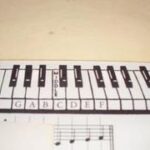Let’s start with the key of A. It’s by far the most common (and easiest) key for the fiddle. Play a two octave A major scale and pay attention to where your fingers go. These are the “legal” notes in the key of A. There are a few more “legal” notes than that, but we’ll get there later when we discuss embellishments and improvisation.
Now, you need to have a CD or a recording of fiddle tunes in order to learn them. Don’t start with some amazing fiddler CD. Try to find a really simple fiddle tune or bluegrass CD. If you have a book, it might seem to make it easier at first, but the darn thing will prove to be a hinderance after a few tunes. Fiddling is an oral tradition, or so to speak. If you don’t already learn well by ear, you need to just bite the bullet and start with something easy. The CD that I made for my students makes it almost too easy. After each fiddle tune, I play it “practice speed” – in other words – really really slow. Even if you don’t have a slow recording, just pick a traditional tune that you like and listen to it over and over. By “over and over” I mean around 100 times. By the time you’re good and sick of the tune, you’re just about ready to learn it. It has to be coursing through your head, so really you’ll have listened to it 1000’s of times, because you’re playing it in your head as well. At that point you can create “practice speed” in your own mind.
Some easy tunes to start with in the key of A are:
Boil the Cabbage Down
Old Joe Clark
Cripple Creek
Red Haired Boy
These tunes are generally way shorter than they seem. Seriously, they’re usually 8 or so measures long. Pick out the notes to about one measure and play them 10 times. Pick out the notes to the next measure and play them 10 times. Make sure you’re always playing SLOW when you’re learning. If you always play the notes correctly, then it doesn’t matter how fast you play it one day, you’ll play the notes correctly. One of the biggest mistakes novice fiddlers make is playing new material too fast because it seems so easy. If you play it incorrectly once, you’re more likely to do it again, and if you do it a lot, you’ll end up practicing mistakes and getting really good at them. So, once you’ve got the two measures perfect on their own, play them together 10 times perfectly. Keep adding measures until the tune is finished. After you’ve done this a few times, if you’ve really listened to a tune enough, it only takes about half an hour to learn a new simple fiddle tune. Also, by learning this way, you’ve never seen the music, and your brain knows that if it’s going to have the pleasure of playing the tune again, it better remember it. Once you’ve recalled a fiddle tune about 30 times, it’s not just that your brain remembers it, it’s really that your fingers do.
Be sure to start your practices by reviewing all of the fiddle tunes you’ve learned. Otherwise, you’ll lose some.
Once you’ve learned one, and you’re finished freaking out on how easy it was to learn, you’ll start gobbling them up. Once you’ve learned a tune in the key of A, start playing the open E and A strings all the time that you’re on either of those two strings. If you dip over to the D string, play the A with it. When your fingers come back to the A, you have to play the open E again as the drone.
There are a few things that fiddlers do frequently that violinists rarely do. One is playing two strings most of the time. Another is finger slides. In violin, this is a glissando, and a potential problem if you miss it. In fiddling, these little bugers are life savers. For instance, in the key of A, a very common half-step finger slide is the second finger on the A string – C natural to C sharp. Practice that little half-step slide for a minute. Now do it while you play the open E string too. Pretty cool, huh? Once you start improvising, this is the ultimate safety net. If you hit a really unacceptable note, you’re probably just one half step away from the bad boy, the note that’s so perfectly placed. So, you just slide, and voila – just as if you meant to.
Irish tunes tend to be in the key of D major or E minor. They’re easy too. Of course, as you improve, you’ll be able to embellish the tunes more and more. All of these traditional tunes can be as easy or tricky as you want them to be.
Honestly, at some point, you’re going to need live people around you to play with and to inspire you. By yourself, you’ll probably lose interest. People are playing traditional music all over this country. There are about 200 tunes in the ether that people all over the nation know how to play. Of all the free things you can do for fun, I can’t think of anything I’ve ever done that’s more fun than sitting in with some strangers and fiddling.
The next step is improvisation, and all it requires is willingness. If we want to be good at something, we have to be willing to be bad at it first. You just have to do it. Figure out what key the tune is in, play the scale a few times, and then go for it. Play with recordings. In fact, if you play with one entire CD a day, you will be a really great improvisationalist in just a few weeks. Dwight Yoakam CDs are great for playing with. The songs are almost always in A, D, G, or E. He’s always tuned to 440 which makes playing with him easy. He generally plays slow and his fiddle player rocks the planet. This player (don’t know who it is) will give you lots of ideas. I’m sure you have some CDs in your collection that you can play with. You have to avoid the ones that are tuned high or low (or tune to them) and ones that are in weird keys.
No one can ever take away your skills or knowledge. You will never be sorry you learned how to fiddle. And good luck. Practice slow.




